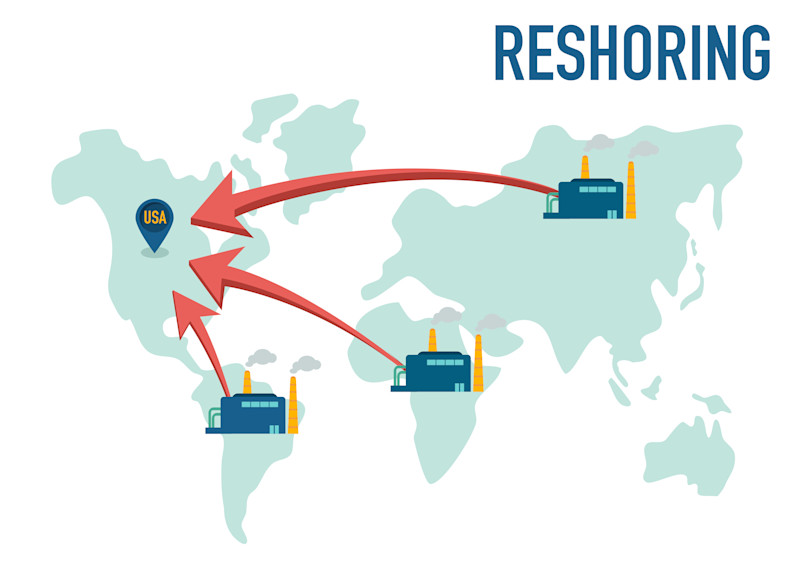U.S. imports of Chinese goods plunged by 13% last year to $500.3 billion, the biggest drop in 30 years. China saw its global exports slump by 4.6% to in 2023, the first full-year decline in seven years. China’s manufacturing activity contracted for a consecutive month in February 2024. In an unprecedented change in trade flows, China exported more to Southeast Asia than the United States in 2023, exemplifying a slow decoupling between the two behemoths.
China’s economic growth is expected to slip to 4.6% in 2024 from its 2023 three-decade-low of , and then plummet to by 2028 according to the International Monetary Fund (IMF). Annual growth is expected to continue slowing to by 2030 according to consulting firm, Capital Economics. In sharp contrast, the U.S. economy is humming along exceeding expectations, with GDP growth of 4.9% and 3.3% in the third and fourth quarters of 2023, respectively.
Geopolitical risk and U.S. industrial policy are driving manufacturing to the United States. The cumulative number of jobs brought back since the manufacturing low in 2010 is now approximately two million.
U.S. manufacturing is coming home.
China’s seismic trade shift China’s share of U.S. container imports has declined to from its 44.5% 2010 peak. Transportation executives anticipate 20% of Asia-originating freight will move closer to markets by 2025 and % by 2030.
China is suffering a one-two punch with weak demand both at home and abroad that is expected to growth in 2024. China’s real-estate crisis is crushing investment, and consumer confidence is near its lowest level in over . Trade barriers, global recession, and weaker demand for Chinese goods will continue to negatively impact China’s economic growth in 2024.
China’s economic slump China’s growth rate plunged to a in 2023. In 2024, China’s stuttering economy is grappling with growth hurdles and mounting debt. It’s struggling to shake off deepening deflation that hasn’t been this severe since .
China’s real estate market, historically representing about a quarter of China's GDP, is in a slump with investments dropping % and new construction starts plummeting %. The IMF predicts real estate investment to fall % over the next decade from 2022 levels.
Adding to the headwinds are structural weaknesses including an aging population, pollution, high youth unemployment, and local Chinese governments struggling with unsustainably high debt levels. China’s debt-to-GDP ratio reached a in 2023. In December 2023, China’s economic outlook was cut to by credit rating agency Moody’s.
China’s shrinking foreign direct investment Foreign direct investment (FDI) into China contracted for the first time in over a decade in 2023, representing an % plunge year-over-year. Its economic downturn and abrasive government policies are to blame. China’s severe measures imposed on U.S. companies include raiding their offices, arresting Chinese employees, and accusing them of spying, espionage, and stealing national security and military secrets.
According to Alicia Garcia Herrero, chief economist for Asia-Pacific at Natixis, “,” due to China's business climate, economic recovery, and politics. The loss of FDI delivers a double blow to China’s economy; first from a loss of economic development, and second from a loss of competency since FDI is the primary means by which knowledge and international best practices are transferred to Chinese firms.
U.S. economy defies the odds Conversely, the U.S. economy is growing and the labor market is strong. U.S. policy has created favorable conditions for reshoring and FDI via the (IIJA), (IRA), and . Since 2021 the United States has had more investment () in EV manufacturing than any other region in the world. Meanwhile, China’s share has dropped from 60% of total global EV investments to less than one-quarter over the same time period.
The U.S. crushed pre-pandemic job , adding in 2023, and had the longest stretch of under 4% unemployment in 50 years. U.S. reshoring is driving a manufacturing construction boom with investment in manufacturing facilities reaching the highest on record (/Q4 2023) and contributing the most to real year-over-year GDP growth since .
Are you thinking about reshoring? For help, contact me at 847-867-1144 or email me at harry.moser@reshorenow.org. Our main mission is to get companies to do the math correctly using our free online (TCO). By using TCO, companies can better evaluate sourcing, identify alternatives and even make a case when selling against offshore competitors.









